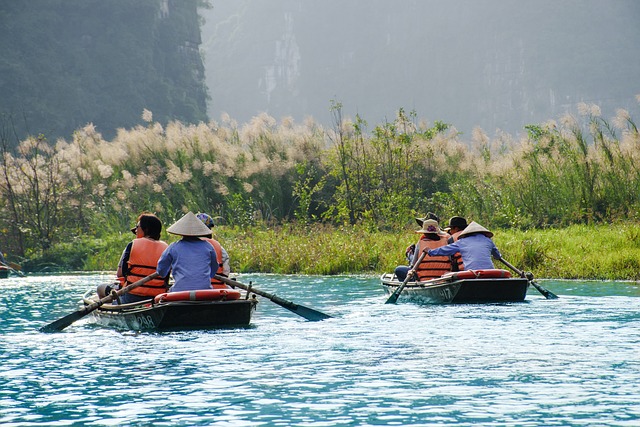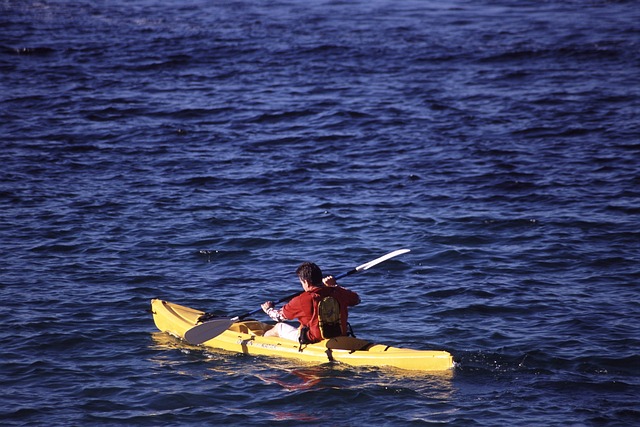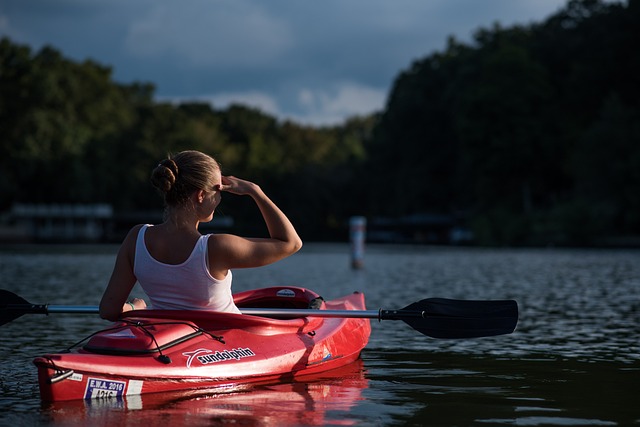Inflatable kayaks for two have gained popularity among outdoor adventurers seeking flexible watercraft options. Key challenges include achieving durability with lightweight, compact designs, especially against puncture-resistant fabrics. Specialized materials engineered to prevent damage from sharp objects are crucial for extending lifespans, enhancing safety, and improving user experiences. When choosing a fabric, prioritize strength and tear resistance; opt for water-repellent, quick-drying materials. Modern innovations like high-density polymers and textured surfaces enhance performance and comfort. Evaluating puncture resistance through tests ensures fabric longevity. Reinforcements at seams and high-stress points increase durability. Proper care routines prolong the kayak's lifespan. Case studies show successful applications of durable fabrics, enhancing safety and flexibility for outdoor enthusiasts. Future developments include sustainable materials and advanced coatings, catering to environmental stewardship.
“Discover the secrets behind crafting durable and puncture-resistant fabrics for inflatable kayaks designed for two. This comprehensive guide explores the critical need for robust materials, delving into key characteristics, innovative constructions, and rigorous testing methods. Learn how reinforcements and proper care extend the lifespan of your kayak fabric. From case studies showcasing successful applications to future trends predicting advanced materials, this article covers all aspects of enhancing durability in inflatable kayaks for two.”
Understanding Puncture-Resistant Fabrics: The Need for Durability in Inflatable Kayaks

Inflatable kayaks have gained immense popularity, especially among outdoor enthusiasts who seek versatile and portable watercraft options. However, one significant challenge in this space is ensuring durability, particularly when it comes to puncture-resistant fabrics. The need for robust materials arises from the very nature of inflatable boats—they are designed to be lightweight and compact, easily stowable, yet capable of withstanding various aquatic environments.
Puncture-resistant fabrics play a crucial role in maintaining the integrity of an inflatable kayak for two (or any type). These specialized materials are engineered to prevent or minimize damage from sharp objects commonly found in water bodies, such as rocks, branches, and underwater debris. By understanding the importance of durability, manufacturers can offer products that provide longer service lives, enhancing the overall experience for kayakers without compromising safety.
Key Characteristics of High-Quality, Puncture-Resistant Materials

When selecting a durable, puncture-resistant fabric for an inflatable kayak for two, key characteristics come to the forefront. First and foremost, the material should exhibit exceptional strength and tear resistance, ensuring it can withstand the rigors of outdoor use, including sharp objects like rocks or branches. This is crucial for maintaining the structural integrity of the kayak, keeping you safe during your adventures.
Additionally, water-repellency and quick-drying properties are essential features. These characteristics not only prevent the fabric from absorbing water, reducing potential weight gain, but also aid in rapid drying after a soak, ensuring minimal downtime between paddling sessions. This is particularly important for inflatable vessels designed for tandem use, where efficient material management can greatly enhance overall performance and user experience.
Material Innovations in Inflatable Kayak Construction

The construction of inflatable kayaks has witnessed significant material innovations, transforming the once-fragile designs into durable and puncture-resistant options. One notable advancement is the introduction of high-density polymers, such as Polyvinyl Chloride (PVC) and Nitrile Butadiene Rubber (NBR), which offer exceptional strength and flexibility. These materials are particularly suitable for inflatable kayaks for two, ensuring they can withstand the rigours of tandem paddling while maintaining their structural integrity.
Additionally, modern fabric technologies have enhanced the overall performance of inflatable kayaks. Textured surfaces and specialised coatings repel water and reduce the risk of punctures, making them ideal for outdoor adventures. These innovations not only improve durability but also contribute to a more comfortable and efficient paddling experience, especially when exploring rivers or coastal areas with varying terrains.
Testing Methods for Evaluating Fabric Resistance to Punctures

Evaluating the puncture resistance of fabric is crucial, especially for applications like an inflatable kayak for two, where durability is key. Several testing methods are employed to simulate real-world conditions and ensure the fabric’s longevity. One common approach is the bursting strength test, which measures the force required to pop a inflated sample of the fabric. This method provides valuable data on the material’s resistance to sudden punctures, mimicking potential impacts during water activities.
Another technique is the needle penetration test, where a standardized needle is used to pierce the fabric, recording the depth of penetration. This simple yet effective process helps determine the fabric’s ability to repel sharp objects, ensuring it can withstand scratches and nicks commonly encountered outdoors. These testing protocols are essential in selecting fabrics for inflatable craft, guaranteeing both safety and performance during outdoor adventures.
Incorporating Reinforcements: A Strategy for Enhanced Durability

Inflatable kayaks, designed for outdoor adventures, demand fabrics that can withstand rigorous use. One effective strategy to enhance the durability and puncture resistance of these fabrics is by incorporating reinforcements. This approach involves integrating stronger materials or additional layers into the fabric structure, specifically at high-stress points. For instance, in an inflatable kayak for two, the seams and areas subject to constant pressure during paddling require reinforcement. By adding reinforced sections, manufacturers can ensure the kayak maintains its structural integrity even after prolonged exposure to sharp objects or rough terrains.
This method not only increases the lifespan of the fabric but also provides peace of mind for kayakers, knowing their equipment is ready for any challenge. Reinforcements act as a protective barrier, preventing small punctures from escalating into significant damage. Thus, it’s a critical step in designing outdoor gear that can withstand the rigors of nature while keeping users safe and secure during their water adventures.
Care and Maintenance Tips to Prolong the Lifespan of Your Inflatable Kayak Fabric

To maximize the lifespan of your durable, puncture-resistant fabric in an inflatable kayak for two, regular care and maintenance are essential. Start by cleaning your kayak after each use with a mild detergent and warm water, avoiding harsh chemicals that could damage the material. Gently wipe down the surface to remove any debris or stains, ensuring you dry it thoroughly afterward to prevent mold or mildew buildup.
Store your inflatable kayak in a cool, dry place away from direct sunlight when not in use. Avoid stacking heavy objects on top of it, as this can cause permanent creasing or damage to the fabric. Periodically inspect for any signs of wear and tear, patching small holes immediately with a suitable repair kit designed for waterproof materials. Regular maintenance will ensure your inflatable kayak for two remains in excellent condition, providing years of enjoyable outdoor adventures.
Case Studies: Successful Applications of Puncture-Resistant Fabrics in Kayaks

Inflatable kayaks for two have benefited immensely from the integration of durable, puncture-resistant fabrics. Case studies highlight successful applications where these innovative materials have significantly enhanced the performance and safety of paddling experiences. For instance, leading outdoor gear manufacturers have designed inflatable kayaks using high-tech fabrics that offer exceptional resistance against sharp objects commonly encountered in aquatic environments. This includes thorns, rocks, and even jagged edges hidden beneath the water’s surface.
The result is a longer lifespan for these kayaks, ensuring that users can enjoy their craft without constant worries about punctures. Moreover, these fabrics provide excellent flexibility and comfort, allowing kayakers to navigate through diverse terrains with ease. This combination of durability and maneuverability has made inflatable kayaks for two a popular choice among outdoor enthusiasts, catering to both leisure and adventure paddling trips.
Future Trends: Predicting Advances in Durable Inflatable Kayak Material Technologies

As technology advances, so does our quest for innovative and sustainable materials. Future trends in durable inflatable kayak for two material technologies look promising, with an emphasis on enhancing tear resistance and overall strength. Researchers are exploring new synthetic blends that offer superior puncture resistance while maintaining flexibility, ideal for crafting robust yet lightweight kayaks capable of enduring rugged waters.
Sustainable practices are also at the forefront, driving developments towards eco-friendly options. This includes the integration of recycled materials and the implementation of advanced water-resistant coatings, ensuring longer lifespans for these watercraft without compromising their performance. These advancements not only cater to the growing demand for durable inflatable kayaks but also align with a broader push for environmental stewardship.
